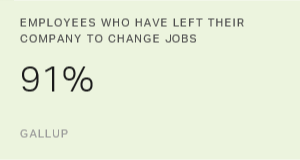Hiring and keeping star employees is every organization's goal and comes with several challenges.
Perhaps the biggest of which is just that -- it's every organization's goal.
What's more, 51% of currently employed adults in the U.S. say they are searching for new jobs or watching for new job opportunities, according to Gallup's State of the American Workplace report. That number climbs to six in 10 for millennials.
That means you're in a battle to keep stars and to find them. You need a competitive edge now more than ever.
In the fight for talent, most human resource departments spend considerable time maximizing employee lifecycles from a process standpoint. And hiring managers and recruiters typically attempt to attract and keep candidates by appealing to their rational minds, luring them with promises of practical benefits.
But we've all ignored one key area.
We forgot to study and try to understand the employee experience, starting with hiring and onboarding, through the lens of emotions.
It's a simple case of heart over head.
Research shows that 70% of decision-making is emotional and 30% is rational. Neuroscientist Antonio Damasio fathered this research by studying people with damage in the area of the brain that is responsible for emotions.
Damasio discovered something remarkable: not only were subjects unable to experience emotions -- they were also unable to make even the simplest decisions. Emotions drive decisions.
So, consider the scenario of a candidate choosing between two job offers that both meet various "rational" criteria: competitive compensation and benefits, 401(k) contributions and located in a market with a reasonable cost of living. Both opportunities meet these criteria, but one organization insists that the candidate visit the area with his or her family to experience it "hands on."
Hearing about a community is one thing, but watching one's family walk in the park and playing with a potential neighbor's Labrador retriever may just seal the deal. Heart over head.
What does today's workforce want?
In the U.S., 35% of employees have changed jobs in the past three years and 91% left their company to do so.
Fortunately, these job hoppers aren't flaky, lazy or non-committal -- they simply seek change due to needs that aren't met by their current employer. That's when they become consumers of the workplace and start shopping around.
Like consumers planning to make a purchase, modern job seekers rely heavily on their emotions and experiences when evaluating opportunities.
Choosing to switch employers -- or stay -- is a big decision that involves rational considerations like compensation and job location. But, it is also swayed heavily by social relationships with potential coworkers, alignment with the mission of the organization and expectations about organizational culture.
People seek opportunities to do what they do best in an organization whose mission inspires them. A mission that makes them feel good about who they are and how they contribute to the bigger picture.
This takes positive, firsthand interactions and tapping into their emotions alongside each step of the employee onboarding experience.
Improve employee engagement early on by crafting your employment branding and onboarding strategies around emotional connections.
Today's job seekers want more -- something that's difficult to convey in a job posting, during technical onboarding or a one-off employee engagement activity.
Organizations increase the likelihood that what they offer not only attracts job seekers, but truly resonates with them, when they pay specific attention to what people experience from an emotional standpoint.
Doing so elevates the engagement level of new hires and sets the stage for a positive onboarding experience.
Failing to do so risks what may be the most critical emotional connection of the employee journey.
Start by asking yourself these questions:
- Is your organization doing what it takes to ensure that candidates feel connected to your company's culture, mission and purpose from the moment they meet you?
- Are you acutely aware of a candidate's unique, emotional needs?
- Are you providing a glimpse of how working for you will help candidates achieve both personal and professional goals and aspirations?
And can they walk in the park and laugh with a Labrador?
If you make these connections, their emotions will get the best of them -- and their best is what they will give you in return.
Learn more about how you can create emotional connections with your employees during hiring and onboarding:
- Download our State of the American Workplace report to gain an in-depth perspective on what employees want most out of a job and company.
- Inquire about our solutions for creating a compelling employment brand and employee value proposition.
- Create a better employee experience from start to finish with Gallup Access, our online survey and management platform.


